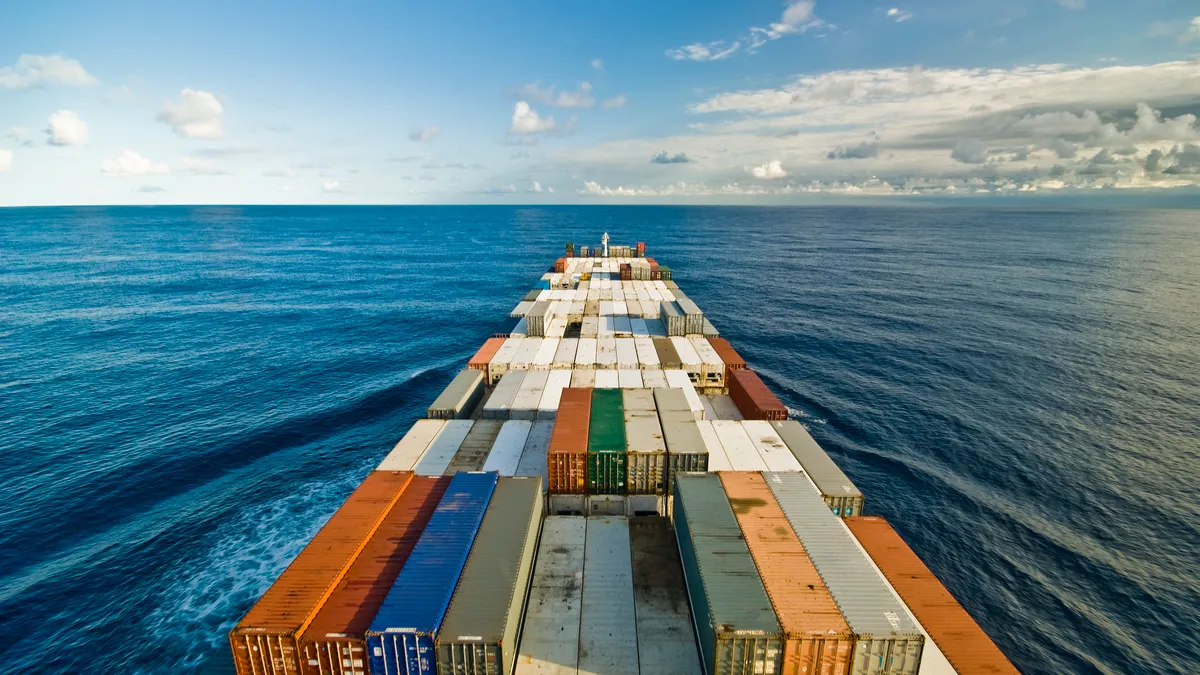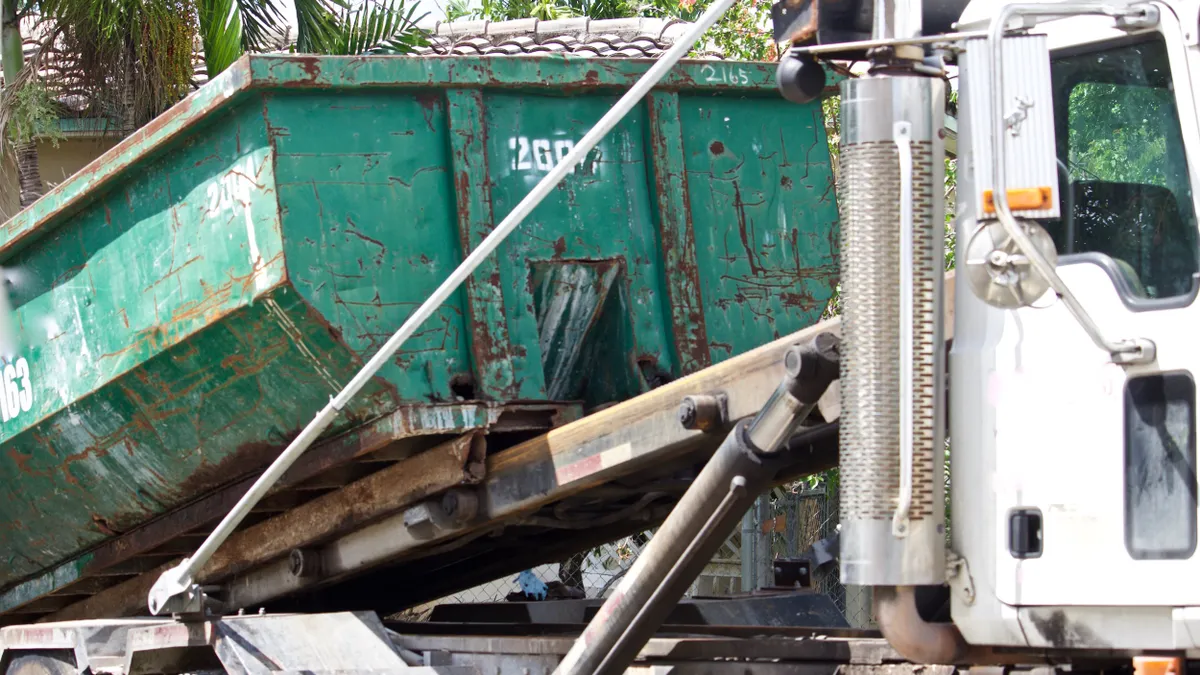Each day, waste industry workers perform vital functions that keep cities clean and communities healthy. Most of those functions remain fundamentally the same year-to-year: collect material, sort it, recover value and dispose of the rest.
And yet, there are shifts each year that change how the industry operates. Composting, glass recycling and the increasing use of compressed natural gas (CNG) helped shape 2016. In 2017, the conversations that moved the industry ranged from China's ongoing policy changes to how the big companies in the industry responded to natural disasters.
In a short reader poll, we asked the Waste Dive audience to signal what trend is most likely to affect the industry in 2018. Nearly 50% of respondents said China would be the biggest story of the year, with other topics falling below 25% of the total vote.
Some of those trends will continue this year — especially when we consider how China's policies, now coming into effect, will shift recycling markets. Other ongoing debates, like the meaning of "zero waste" and the idea of franchised collections, will undoubtedly be affected by the new Chinese policies and how the U.S. and industry organizations respond. Here are six trends that will be worth watching as 2018 kicks off.
1. The full enforcement and continued effects of China's import policies
According to reader feedback, China's new import policies continue to dominate the recycling conversation and will be one of the top stories to watch in 2018 — even if the country works with trade organizations to compromise, as some hope or expect. Now that the import restriction date has officially passed for the 24 banned materials, the pressure points will become even more clear. Companies and brokers have already begun looking to Southeast Asia in anticipation, and the situation at West Coast ports is shifting as a result.
Many are still just as concerned, if not more so, about the March contamination specifications. Meeting the slightly relaxed 0.5% standard without a major upgrade is still seen as nearly impossible. For those that already do single-stream, and may be having challenges finding a market for glass, the situation is additionally frustrating.
It's possible that the tax reform windfall will free up funds to invest in new sorting equipment — including artificial intelligence — at MRFs. In the meantime, companies have also been staffing up and slowing down lines. Relying on staffing agencies to do that may have also gotten easier now that the BFI joint employer standard has been overturned and the industry hopes to reinforce that policy with legislation. How companies prioritize safety, and whether the addition of new employees coupled with slower work speeds affects injury rates, will be particularly interesting to watch.
2. The continued debate over franchising in cities across the U.S.
Uttering the words "franchise" or "zoned collection" is one of the easiest ways to strike fear in many of the industry's smaller service providers. As consolidation continues, their ability to compete on price in an open market is one of the few guaranteed selling points they have left. Technology companies and brokers that rely on their relationships with these providers are also opposed to the concept.
Yet the industry's largest companies have made no secret about their support for franchising — at the right price — and will have multiple opportunities to help advance it this year.
This will be the case as discussions continue from smaller cities such as Springfield, MO and St. Paul, MN to New York, and possibly Boston. Existing contracts in states such as California and Nevada can also be expected to receive ongoing attention. The Los Angeles recycLA system may be the most prominent example, spurring strong reactions from all sides. For environmental groups and franchise supporters, it's a sign of what's possible elsewhere. Though for detractors and real estate interests it's already becoming a cautionary tale.
3. The continued and gradual deployment of technology in the industry
Perhaps as a sign of the year to come, the biggest company in the industry, Waste Management, hired its first chief digital officer as 2017 was coming to a close. Additionally, 2017 saw that company invest in fleet data capture and next-generation landfills. Penn Waste saw a big increase in efficiency by deploying artificial intelligence (AI) in a MRF and Lytx unveiled its newest video software.
These investments and experiments will continue into 2018 and likely beyond. While the waste industry is sometimes seen as slow to change, big players are continuing to put resources into tech to improve efficiency and safety. The gradual deployment of new tech in the industry will bring, as one leading voice said, "waves of change." That change, in 2018, will likely look like the increasing use of electric or hybrid vehicles, increased interest in autonomous vehicles and, of course, continuing use of CNG for fueling vehicles.
These technologies and others, including the use of AI, could help improve efficiency and safety. While there were fewer fatalities in 2016 than 2017, refuse collection remains the fifth-most dangerous occupation in the country — so any improvements in safety could mean big outcomes for the industry.
4. The ongoing debate over how to define "zero waste"
As all of these more tangible trends play out, 2018 will also be a year of continued "zero waste" aspirations — and perhaps some reckoning. Nearly every major city has some type of "zero waste" or ambitious recycling diversion goal at this point. Fewer have a clear plan for how to achieve those goals or can agree on what the terminology actually means.
All supporters agree this means limiting landfill usage, but from there it has become a very adaptable concept. Some cities will be taking the European model of using waste-to-energy as an interim disposal solution. Others have shunned disposal technology of any kind — even though they still rely on it to some degree — and are holding out for a more viable circular economy solution around universally recyclable packaging.
Many packaging manufacturers have set lofty targets of their own, and found creative ways to demonstrate movement, but may not be ready to enact more meaningful changes. For many of the cities with their own goals that could also be the case. Diverting organic waste and finding ways to limit other types of traditionally unrecyclable packaging is a critical first step. Finding ways to keep that up on a consistent basis, and actually engage people enough to change their behavior will be another story.
With contamination an issue in many cities, and more harmful to the viability of scrap markets than it has been in years due to China, the "zero waste" movement could be overdue for a reality check. Progress is happening, and much more of it is possible, but all involved may need to be more honest about the systemic changes required to make that happen.
5. The industry effects of tax reform — and what that could mean for M&A
The industry has experienced rapid consolidation in recent decades. Based on what executives have been saying in earnings calls and interviews there could be much more ahead.
Now that President Trump has signed the largest corporate tax cut in recent history — without including some elements that concerned the industry in previous versions — companies will have a lot more capital on hand. Waste Connections CEO Ron Mittelstaedt has previously predicted an M&A "bonanza." Others have been similarly bullish and the bill was a top priority for executives throughout 2017.
Whether this will lead to more high-profile deals like the recent Progressive Waste Solutions or ReCommunity acquisitions remains to be seen. Tuck-ins are already prevalent and smaller family-owned operations will continue to be popular targets.
In the short-term, this may mean national or regional companies can bring some of their more modern capabilities to small communities. That will be especially useful as collection efficiencies and recycling contamination continue to be big priorities. Communities could also see economies of scale by having access to larger networks of processing and disposal facilities. While drivers and other front-line workers remain in high demand, this consolidation could also mean lay-offs for employees in office or managerial roles.
This can all be expected to make financial analysts and shareholders very happy. Whether it will translate to the workers from acquired companies getting better pay, communities getting better service, and more material going to the highest and best use, will be key areas to watch.
6. The influence of the Environmental Protection Agency
Under Administrator Scott Pruitt, the Environmental Protection Agency has offered some clarification on New Source Performance Standards for landfills and announced plans to aggressively target some Superfund sites for cleanup and remediation.
However, the agency has also been party to significant drama concerning the Renewable Fuel Standard (RFS). While RFS volumes are set for 2018, the political back-and forth is unlikely to come to an end. The EPA's decision to enforce — or not to enforce — emissions standards could influence how landfills operate. The battle over the RFS could influence how biogas producers choose to invest in anaerobic digestion for food waste or other organic feedstock.
Pruitt’s commitment to getting the EPA "back to basics" and Trump's deregulatory agenda could combine in 2018 to mean big shifts for how the waste industry is regulated at the federal level.





















